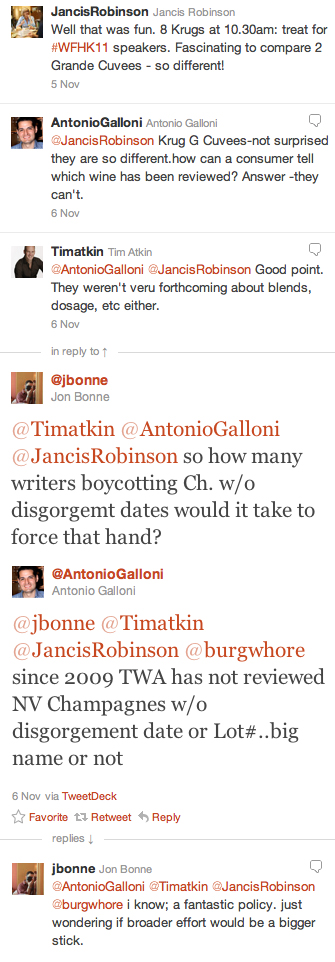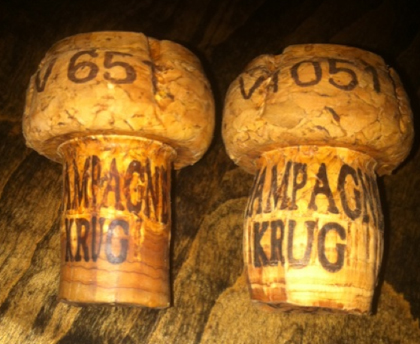Are you for Champagne disgorgement dates? We are!
When you’re shopping for bubbly between now until New Year’s Eve, how will you know how long that nonvintage bottle has been on the shelf? If there were a disgorgement date on the label, you would have a better clue.
Over the weekend, Jancis Robinson tasted two Krug Grande Cuvée wines and commented on Twitter how different they were. Antonio Galloni of Robert Parker’s The Wine Advocate replied to her that the WA has not reviewed Champagne without a disgorgement date since 2009. (See exchange below.) Jon Bonné of the San Francisco Chronicle wondered how many writers it might take to adopt the same policy to force the producers’ hand in the region. It’s a stick approach.
Here’s a carrot for the producers: disgorgement dates will engage the most interested consumers. These are the ones that should be of particular interest to producers since they would look up further information on the producer web site and alert their world to their experience (good or bad) via social media.
Disgorgement dates are important. After the jump, check out Champagne writer Peter Liem, who is pro-disgorgement labeling, giving his reasons why they are important. I’m in favor of Champagne producers putting some sort of legible, comprehensible form of disgorgement dates on the (back) label. If you are too, hit the comments!
Why is the disgorgement date important? The simplest reason is that bottles disgorged at different times are, in effect, different wines. A particular cuvée of either non-vintage or vintage champagne will see several different disgorgements over the time that it’s sold. This is done for practical, physical reasons in the cellars, and also because leaving a champagne on its lees keeps it fresher while waiting for the next outgoing shipment. But since they spend different amounts of time on the lees the wines will necessarily be different, even if these differences are subtle. The amount of post-disgorgement aging will obviously be different as well, which has perhaps an even bigger impact on the wine. Furthermore, it’s a relatively common practice to adjust the dosage for different disgorgements of the same wine: earlier disgorgements usually take a higher dosage, because the acidity is more pronounced. In contrast, the dosage is often reduced for later disgorgements, as the wine mellows out and the acidity becomes rounder and less aggressive…
The main reason I like knowing the disgorgement date is not to find the “best†version of a cuvée, but to know what to expect when I open the bottle. A bottle disgorged six months ago is going to be different in character than the same wine disgorged two years ago. Since I prefer wines with more post-disgorgement age, I’ll usually pick the older one if there’s a choice. In truth, I actually enjoy tasting different disgorgements of the same wine, and find it to be a very instructive activity.
And the exchange on Twitter:

Krug corks photo from Raj Parr who added that with Krug Grande Cuvée, “you can only tell by the cork!”
UPDATE: Decanter.com reports that Krug Grand Cuvée will have disgorgement dates: “the code will also link to information about the harvest conditions prevailing in the year on which the wine is based, which makes up the majority of the blend. In London for the launch of Krug Vintage 2000 and Clos du Mesnil 2000, director Olivier Krug (pictured) said though both he and chef de cave Eric Lebel attach little importance to disgorgement dates and he doesn’t think Krug drinkers do either.”





On November 8th, 2011 at 10:45 am ,Vincent Renault wrote:
Great post. Very much pro disgorgement date.
In my opinion it makes even more sense for NV champagnes. Without a vintage date on the label, how do you know how “fresh” the NV you are getting will be ? A lot of NV’s in the marketplace, if they should not be drunk too early after disgorgement, probably will not show too well after many years either.
Plus it is a great tool for sommeliers to manage their champagne cellar.
On November 8th, 2011 at 11:21 am ,Wolfe's Wines wrote:
Freshness matters more with NV wines…
Bubble heads want to know how old their wines are…Freshness dates on EVOO, Craft Beers…why not, kinda like driving with out a gas gauge…..Drink grower bubbles and support a farmer who uses disgorgement dates!
On November 8th, 2011 at 11:26 am ,Charlie Olken wrote:
The treatment of consumers by the Champagne houses is one of the last bastions of dishonesty in the wine business. It rates right up there with folks who will bottle second and third and later batches of still wines, sometimes from different sources without so much as a “by your leave” on the label.
But, I don’t blame the Champagne houses or the big volume producers. I blame the regulatory folk who can have arcane rules for how much water can be applied to a vineyard but will not protect the consumer from misleading labeling practices.
Disgorgement dates on bubbly would help, but since so much bubbly is focused on the wines of a vintage even when not vintage-dated, disgorgement dates only help consumers get relatively fresher stock (an important piece of information by itself, of course) but do not protect against against changes in base cuvee without any indication that it has happened.
It is why my bubbly tastings each fall are from fresh stock that I procure directly from the producers in the hope that what I taste in October will be what will be on the shelves in December.
There is no guaranteee, of course, and I woudd support any move to improve the situation.
On November 8th, 2011 at 11:46 am ,Chuck Hayward wrote:
Antonio Galloni should be applauded for taking the lead position on this issue. In preparing JJ Buckley’s annual champagne report, we make a proactive effort to determine disgorgement dates and lot numbers and list them in our reviews. This is simply a matter of ensuring that the consumer has all the necessary information needed to make an appropriate purchasing or drinking decision. The lack of transparency about this information from champagne houses and their importers is appalling.
On November 8th, 2011 at 11:52 am ,Sharon Kapnick wrote:
Sure! Anything that gives the consumer more information about what they’re buying is a good idea.
On November 8th, 2011 at 2:11 pm ,ElGordo wrote:
Gotta love Bruno Paillard!
On November 8th, 2011 at 3:39 pm ,Todd - VT Wine Media wrote:
Certainly disgorgement dates should be included…obvioulsy the producer keeps a record, and it is a simple requirement to have the label reflect.
We make bubbly at home, and we actually do not disgorge, partially as a time and process saver, but also because no one seems to care. After serving hundreds of glasses, not a single soul has refused to drink, even when it has been pointed out. Maybe acceptance is there because of enough craft beer being made, that has yeast remains in the bottle, or that folks know there are B complex vitamins.
What are the chances that non-disgorged bubbly could marketed successfully? It might riddle the Veuve Cliquot in her tomb, but would certainly reduce production costs.
On November 8th, 2011 at 6:24 pm ,Robin C wrote:
I have always been mystified by NV champagnes and why it didn’t seem to matter when they were bottled. I think it’s great to be given more information about the champagnes – it only increases the interest in the process.
On November 8th, 2011 at 8:07 pm ,Bill wrote:
I favor disgorgement dates. I think it not only provides benefit to the consumer but can also build trust and value of reputation for the producers.
On November 9th, 2011 at 7:42 am ,Terroirist » Daily Wine News: Washington Privatizes! wrote:
[…] dates are important. On Dr. Vino, Tyler Colman explains why he’s “in favor of Champagne producers putting some sort of legible, […]
On November 9th, 2011 at 3:54 pm ,Dave Erickson wrote:
Bertrand Gautherot of Champagne Vouette et Sorbeé puts his disgorgement dates right on the label where you can see them.
No secret decoder ring required.
On November 11th, 2011 at 7:37 am ,1WineDude wrote:
Here’s another incentive – in the efforts to differentiate themselves as the original region of bubbly, and differentiate themselves *from* other regions that make bubbly, having a DD is another item to add to that checklist (“Well son, *real* Champagne also carries a indication of its DD…”).
I’m all for it.
On November 12th, 2011 at 9:24 pm ,the zinfidel wrote:
I am so personally and professionally against scores. In fact, here is how I really feel about scores. They are irrelevant and useless. In fact,they are a negative in my book. As in, if you are said super critic and you give it 95 points, I don’t want anything to do with it. So you want to know why I write a wine blog, and why I like wine blogs, especially ones which eschew scores, well the reason why is that they actually say something about the individuality of wines. Scores, what are they good for, absolutely nothing. Say it again…
On November 13th, 2011 at 7:32 pm ,Dave McIntyre wrote:
Yes! Consumers deserve more information, not less. What they do with it – and how much they care about it – is up to them. But I don’t like the Champagne houses deciding for me that I don’t need that information.
Same argument goes for ingredient labeling.
On November 16th, 2011 at 9:54 am ,online wine store wrote:
I agree, anything that provides the consumer with more information to be able to make a wise decision seems like a good idea.
On November 25th, 2011 at 7:09 pm ,Warren Edwardes wrote:
All wines have to have a Lot Number on the label for tracing purposes. The Lot number will (probably) indicate the disgorgement / labelling date. But perhaps the bottling date – anybody know the Lot number system for sparkling wines – bottling or labelling date?]
So no need to boycott particular wines. Just ask the winery for a table with lot numbers and labelling dates and bottling dates.
On December 8th, 2011 at 6:09 pm ,Just say yes to disgorgement dates | Making Wine Labels wrote:
[…] writers, myself included, voiced our support for his stance, most recently in some Twitter banter noting the problem last […]
On June 17th, 2012 at 8:35 am ,Vendita Champagne wrote:
I absolutely agree. Not only you risk of buying a champagne that is too old, but also you risk drinking a champagne too young. You may find to sharp acidity especially when the wine doesn’t do malolactic fermentation or a prevalent sweetness if the liquor de expedition didn’t have the time to settle. There are also some champagne lovers who prefers some oxidative notes and therefore buys today a Bollinger RD 1990. In general disgorgement dates tells you more of what you can expect opening the bottle.
On August 20th, 2012 at 5:02 pm ,Champagne Francis Boulard Rosé Brut Nature « Darren Brogden wrote:
[…] Dr Vino – disgorgement […]
On October 5th, 2012 at 3:13 pm ,Gregg Stephenson wrote:
The pressure needs be applied on all levels – Reviewers, Importers, Major Retailers – to affect real change that’s needed from the Champagne Houses. I applaud those who are making this a mission!
On October 22nd, 2012 at 9:44 am ,A vote against disgorgement dates: Peter Wasserman | Dr Vino's wine blog wrote:
[…] the ongoing debate about whether champagnes should have disgorgement dates on the labels, discussion has mostly been in favor of the practice. Some critics refuse to review a […]